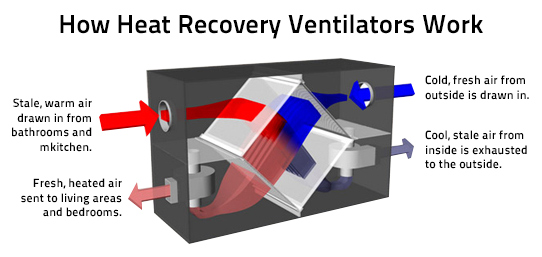How HRV Improves Indoor Air Quality and Comfort at Home
Wiki Article
Discovering the Advantages of Heat Recovery Ventilation for Energy Effectiveness in Homes
Heat Recovery Ventilation (HRV) systems offer house owners a sensible method to enhancing energy efficiency. By reclaiming heat from outward bound air, these systems can substantially decrease home heating and air conditioning prices. Additionally, they give a steady supply of fresh air, boosting indoor air top quality and convenience degrees. As property owners take into consideration lasting alternatives, understanding the subtleties of HRV systems comes to be significantly vital. What aspects should one assess prior to making such an investment?Recognizing Heat Recovery Ventilation Systems

How HRV Improves Indoor Air High Quality

Power Cost Savings: The Financial Benefits of HRV
Maximizing energy effectiveness, heat recovery ventilation (HRV) systems offer significant financial benefits for homeowners. By recouping and recycling heat from exhaust air, HRVs markedly decrease cooling and heating expenses. This technology can cause power cost savings of up to 30%, depending on climate and use patterns. Homeowners often notice reduced energy bills soon after setup, making HRVs a monetarily smart about his financial investment with time. Additionally, several regions offer incentives or refunds for energy-efficient upgrades, better improving the monetary appeal. As power rates remain to climb, the cost-effectiveness of HRVs becomes progressively clear. Generally, the consolidation of HRV systems not just advertises energy efficiency but also adds to long-term monetary savings for households.The Environmental Influence of Heat Recovery Ventilation
A significant ecological benefit of heat recovery ventilation (HRV) systems lies in their capability to reduce overall energy intake. By redeeming heat from exhaust air and transferring it to incoming fresh air, HRV systems lessen the requirement visit this website for energy-intensive heating and cooling down techniques. This decrease in energy need adds to decrease greenhouse gas exhausts, as much less nonrenewable fuel source is required to maintain comfortable indoor temperature levels. In addition, HRV systems improve interior air high quality by successfully trading stagnant air with fresh exterior air, reducing reliance on mechanical cooling systems that can damage the atmosphere. Overall, the application of HRV systems supports sustainable living methods and lines up with global efforts to deal with climate adjustment by promoting power effectiveness in residential settings.
Choosing the Right HRV System for Your Home
Exactly how can homeowners guarantee they select the best heat recovery ventilation (HRV) system for their needs? Initially, they need to assess their home's dimension and layout, as these variables influence air movement demands. Next off, evaluating the system's efficiency ratings is essential, as greater ratings suggest much better efficiency and energy financial savings. Homeowners need to also take into consideration installment and maintenance prices, comparing various brand names and designs for worth. Furthermore, it is necessary to examine sound degrees, as some systems run even more silently than others. Consulting with HVAC specialists can supply customized suggestions based on details home problems. Finally, analyzing user evaluations and service warranties can help in making an educated choice, guaranteeing that the picked HRV system efficiently enhances interior air quality and energy performance.Frequently Asked Concerns

Just how Usually Should I Clean or Keep My HRV System?
The frequency of cleansing or keeping a warmth recuperation ventilation (HRV) system generally depends upon use and environmental aspects. Usually, it is advisable to perform upkeep every six months to assure peak performance and air top quality.
Can HRV Equipments Aid Minimize Moisture Degrees Indoors?
HRV systems can properly lower interior humidity levels by trading stagnant, damp air with fresh, drier air from outdoors. HRV Heat Recovery Ventilation. This process assists Web Site keep a well balanced interior setting, enhancing comfort and stopping moisture-related concerns
What Is the Life-span of a Typical HRV System?
The life-span of a normal heat recovery ventilation (HRV) system differs, usually lasting in between 10 to 15 years. Normal upkeep can expand its effectiveness and functional life, making certain peak efficiency throughout its use period.Exist Any Type Of Noise Interest In HRV Solutions?
Sound interest in HRV systems can develop, specifically from fan procedure. However, several contemporary systems are designed to minimize audio degrees, guaranteeing they operate quietly while maintaining effectiveness, which attends to possible disruptions in living settings.Can I Install an HRV System Myself, or Do I Need a Specialist?
The individual contemplated whether to set up the heat recovery ventilation (HRV) system directly or work with a professional. Generally, while do it yourself installment is possible, know-how warranties appropriate performance and conformity with local building regulations, improving system efficiency.Report this wiki page